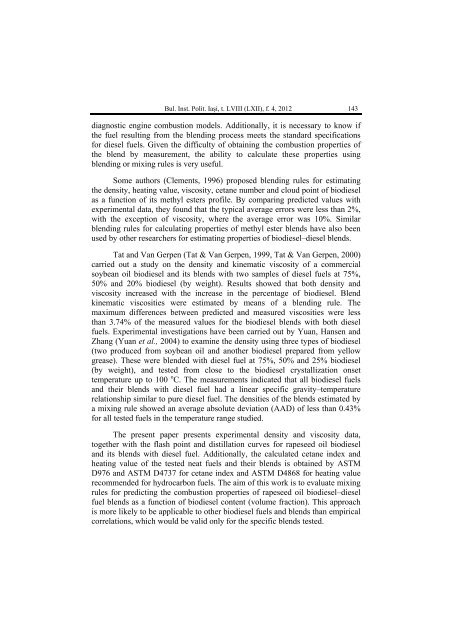buletinul institutului politehnic din iaşi - Universitatea Tehnică ...
buletinul institutului politehnic din iaşi - Universitatea Tehnică ...
buletinul institutului politehnic din iaşi - Universitatea Tehnică ...
You also want an ePaper? Increase the reach of your titles
YUMPU automatically turns print PDFs into web optimized ePapers that Google loves.
Bul. Inst. Polit. Iaşi, t. LVIII (LXII), f. 4, 2012 143<br />
diagnostic engine combustion models. Additionally, it is necessary to know if<br />
the fuel resulting from the blen<strong>din</strong>g process meets the standard specifications<br />
for diesel fuels. Given the difficulty of obtaining the combustion properties of<br />
the blend by measurement, the ability to calculate these properties using<br />
blen<strong>din</strong>g or mixing rules is very useful.<br />
Some authors (Clements, 1996) proposed blen<strong>din</strong>g rules for estimating<br />
the density, heating value, viscosity, cetane number and cloud point of biodiesel<br />
as a function of its methyl esters profile. By comparing predicted values with<br />
experimental data, they found that the typical average errors were less than 2%,<br />
with the exception of viscosity, where the average error was 10%. Similar<br />
blen<strong>din</strong>g rules for calculating properties of methyl ester blends have also been<br />
used by other researchers for estimating properties of biodiesel–diesel blends.<br />
Tat and Van Gerpen (Tat & Van Gerpen, 1999, Tat & Van Gerpen, 2000)<br />
carried out a study on the density and kinematic viscosity of a commercial<br />
soybean oil biodiesel and its blends with two samples of diesel fuels at 75%,<br />
50% and 20% biodiesel (by weight). Results showed that both density and<br />
viscosity increased with the increase in the percentage of biodiesel. Blend<br />
kinematic viscosities were estimated by means of a blen<strong>din</strong>g rule. The<br />
maximum differences between predicted and measured viscosities were less<br />
than 3.74% of the measured values for the biodiesel blends with both diesel<br />
fuels. Experimental investigations have been carried out by Yuan, Hansen and<br />
Zhang (Yuan et al., 2004) to examine the density using three types of biodiesel<br />
(two produced from soybean oil and another biodiesel prepared from yellow<br />
grease). These were blended with diesel fuel at 75%, 50% and 25% biodiesel<br />
(by weight), and tested from close to the biodiesel crystallization onset<br />
temperature up to 100 o C. The measurements indicated that all biodiesel fuels<br />
and their blends with diesel fuel had a linear specific gravity–temperature<br />
relationship similar to pure diesel fuel. The densities of the blends estimated by<br />
a mixing rule showed an average absolute deviation (AAD) of less than 0.43%<br />
for all tested fuels in the temperature range studied.<br />
The present paper presents experimental density and viscosity data,<br />
together with the flash point and distillation curves for rapeseed oil biodiesel<br />
and its blends with diesel fuel. Additionally, the calculated cetane index and<br />
heating value of the tested neat fuels and their blends is obtained by ASTM<br />
D976 and ASTM D4737 for cetane index and ASTM D4868 for heating value<br />
recommended for hydrocarbon fuels. The aim of this work is to evaluate mixing<br />
rules for predicting the combustion properties of rapeseed oil biodiesel–diesel<br />
fuel blends as a function of biodiesel content (volume fraction). This approach<br />
is more likely to be applicable to other biodiesel fuels and blends than empirical<br />
correlations, which would be valid only for the specific blends tested.

















